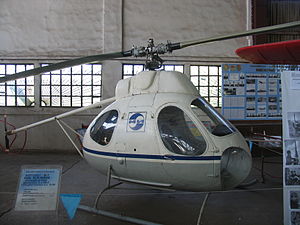| V-7 | |
|---|---|

| |
| Role | Experimental tip-drive helicopter |
| Manufacturer | Mil |
| First flight | 1959 |
| Introduction | 1958 |
The Mil V-7 was an experimental four-seat helicopter with AI-7 ramjets at the tips of the two rotor blades.[1] It had an egg-shaped fuselage, skid undercarriage, and a two-bladed tail rotor on a short tubular tail boom. Four aircraft were built in the late 1950s, but only one is known to have flown, with only the pilot aboard.[2]
Specifications
[edit]Data from The Osprey Encyclopaedia of Russian Aircraft 1875–1995[2]
General characteristics
- Crew: 1
- Capacity: 3 passengers
- Empty weight: 730 kg (1,609 lb)
- Gross weight: 835 kg (1,841 lb)
- Powerplant: 2 × Ivchenko AI-7 ramjets, 0.549 kN (123.5 lbf) thrust each
- Main rotor diameter: 11.6 m (38 ft 1 in)
Well, that’s interesting to know that Psilotum nudum are known as whisk ferns. Psilotum nudum is the commoner species of the two. While the P. flaccidum is a rare species and is found in the tropical islands. Both the species are usually epiphytic in habit and grow upon tree ferns. These species may also be terrestrial and grow in humus or in the crevices of the rocks.
View the detailed Guide of Psilotum nudum: Detailed Study Of Psilotum Nudum (Whisk Fern), Classification, Anatomy, Reproduction